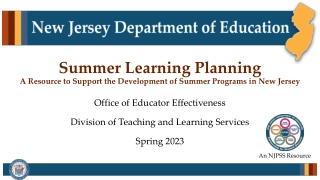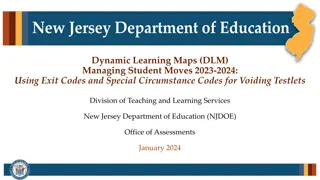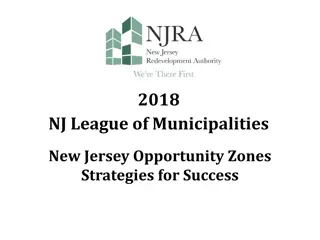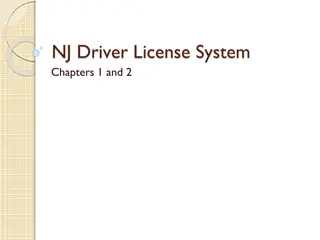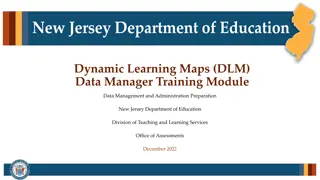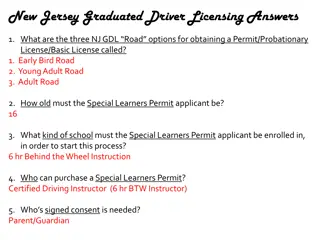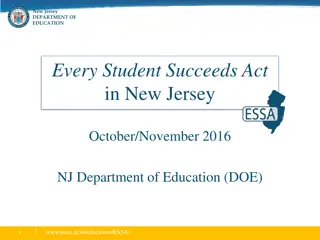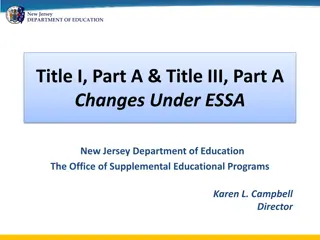Update on 2023 New Jersey Student Learning Standards for Mathematics
The 2023 New Jersey Student Learning Standards for Mathematics have been adopted and are set to be implemented in September 2024. The structural revisions include changes in domains such as Measurement, Data Literacy, and Geometry. Revisions in indicators and elementary standards aim to enhance topics like money, data literacy, fractions, and visual models. Support for Local Education Agencies (LEAs) will be provided through the Standards Transparency and Mastery Platform (STAMP).
Download Presentation

Please find below an Image/Link to download the presentation.
The content on the website is provided AS IS for your information and personal use only. It may not be sold, licensed, or shared on other websites without obtaining consent from the author.If you encounter any issues during the download, it is possible that the publisher has removed the file from their server.
You are allowed to download the files provided on this website for personal or commercial use, subject to the condition that they are used lawfully. All files are the property of their respective owners.
The content on the website is provided AS IS for your information and personal use only. It may not be sold, licensed, or shared on other websites without obtaining consent from the author.
E N D
Presentation Transcript
Overview of the 2023 New Jersey Student Learning Standards for Mathematics Office of Standards Division of Teaching and Learning
Agenda Adoption and Implementation Timeline K 5 Structural Revision Summary of Revisions and Examples Next Steps 2
Adoption and Implementation NJSLS-Mathematics were adopted by the State Board of Education on October 4, 2023. Per SBOE Resolution, NJSLS-Mathematics will be implemented by LEAs in September 2024. LEAs will be supported through technical assistance and resources available through the Standards Transparency and Mastery Platform (STAMP).
K5 Structural Revision 2016 Domains Measurement and Data (MD) Geometry (G) Counting and Cardinality (CC) Number and Operations in Base Ten (NBT) Number and Operations Fractions (NF) Operations and Algebraic Thinking (OA) 2023 Domains Measurement (M) Data Literacy (DL) Geometry (G) Counting and Cardinality (CC) Number and Operations in Base Ten (NBT) Number and Operations Fractions (NF) Operations and Algebraic Thinking (OA)
Text Version: KHS Domain Progression Key: F: Functions G: Geometry M: Measurement NBT: Number and Operations in Base Ten NF: Number and Operations Fractions OA: Operations and Algebraic Thinking SP: Statistics and Probability A: Algebra CC: Counting and Cardinality DL: Data Literacy K 1 2 3 4 5 6 7 8 HS CC - - - - - - - - - NBT NBT NBT NBT NBT NBT RP RP - NQ - - - NF NF NF NS NS NS NQ OA OA OA OA OA OA EE EE EE A OA OA OA OA OA OA - - F F G G G G G G G G G G M M M M M M G G G G DL DL DL DL DL DL SP SP SP SP
Summary of Revisions K 5 Indicator Revisions Elementary Standards involving Money Data Literacy Standards (NEW) Fractions and Visual Fraction Models Perspectives on Accuracy and Efficiency Revised Progressions: Grade 8 to High School High School Plus Standards 7
K5 Indicator Revision: Example 1 Type 2023 NJSLSM 2016 NJSLSM K.M.A.1 Describe measurable attributes of K.MD.A.1 Describe measurable attributes of objects, such as length or weight. Describe objects, such as length or weight. Describe Indicator several measurable attributes of a single object. several measurable attributes of a single object. K.M.A.2 Directly compare two objects with a K.MD.A.2 Directly compare two objects with a measurable attribute in common, to see which measurable attribute in common, to see which object has more of / less of the attribute, and object has more of / less of the attribute, and Indicator describe the difference. For example, directly describe the difference. For example, directly compare the heights of two children and compare the heights of two children and describe one child as taller/shorter. describe one child as taller/shorter. 8
K5 Indicator Revision: Example 2 Type 2023 NJSLSM 2016 NJSLSM K.DL.A.1 Classify objects into given categories; K.MD.B.3 Classify objects into given categories; count the numbers of objects in each category count the numbers of objects in each category Indicator and sort the categories by count. (Clarification: and sort the categories by count. Limit category counts to be less than or equal to 10) 1.DL.A.1 Organize, represent, and interpret data 1.MD.C.4 Organize, represent, and interpret with up to three categories; ask and answer data with up to three categories; ask and answer questions about the total number of data points, questions about the total number of data points, Indicator how many in each category, and how many how many in each category, and how many more or less are in one category than in another. more or less are in one category than in another. 9
New Elementary Standards on Money Expectations for understanding coins, dollars, and their respective values are proposed. Examples of new standards addressing money are: K.M.B.3 Understand that certain objects are coins and dollars, and that coins and dollars represent money. Identify the values of all U.S. coins and the one-dollar bill. 1.M.C.4. Know the comparative values of coins and all dollars (e.g., a dime is of greater value than a nickel). Use appropriate notation (e.g., 69 , $10). 10
Content Emphases in Mathematics To say that some things have greater emphasis is not to say that anything in the Standards can be neglected or omitted in instruction. Neglecting material will leave gaps in student skill and understanding and may leave students unprepared for the challenges of a later grade. 11
STAMP: Content Emphases K-8 Content Emphases resources will be made available as part of the Standards Transparency and Mastery Platform 12
Money in Grade 2, continued 2.M.C.8 Solve word problems involving dollar bills, quarters, dimes, nickels, and pennies, using $ and symbols appropriately. Example: If you have 2 dimes and 3 pennies, how many cents do you have? 2.NBT.B.2. Count within 1000; skip-count by 5s, 10s, and 100s. 13
Money in Grade 2 2.M.C.8 Solve word problems involving dollar bills, quarters, dimes, nickels, and pennies, using $ and symbols appropriately. Example: If you have 2 dimes and 3 pennies, how many cents do you have? 2.OA.A.1. Use addition and subtraction within 100 to solve one- and two-step word problems involving situations of adding to, taking from, putting together, taking apart, and comparing, with unknowns in all positions, e.g., by using drawings and equations with a symbol for the unknown number to represent the problem. 14
Money in grade 3 3.OA.D.8 Solve two-step word problems, including problems involving money, using the four operations. Represent these problems using equations with a letter standing for the unknown quantity. Assess the reasonableness of answers using mental computation and estimation strategies including rounding. (Clarification: This standard is limited to problems posed with whole numbers and having whole number answers; students should know how to perform operations in the conventional order when there are no parentheses to specify a particular order) (Order of Operations) 15
Money in grade 4 4.M.A.2 Use the four operations to solve word problems involving distances, intervals of time, liquid volumes, masses of objects, and money, including problems involving simple fractions or decimals, and problems that require expressing measurements given in a larger unit in terms of a smaller unit. Represent measurement quantities using diagrams such as number line diagrams that feature a measurement scale. 16
Measurement vs. Data Literacy K K.DL.A.1 Classify objects into given categories; count the numbers of objects in each category and sort the categories by count. (Clarification: Limit category counts to be less than or equal to 10) K.M.A.1 Describe measurable attributes of objects, such as length or weight. Describe several measurable attributes of a single object. K.M.A.2 Directly compare two objects with a measurable attribute in common, to see which object has more of / less of the attribute, and describe the difference. For example, directly compare the heights of two children and describe one child as taller/shorter. 17
Measurement vs. Data Literacy Grade 1 1.M.A.1 Order three objects by length; compare the lengths of two objects indirectly by using a third object. 1.M.A.2 Express the length of an object as a whole number of length units, by laying multiple copies of a shorter object (the length unit) end to end; understand that the length measurement of an object is the number of same-size length units that span it with no gaps or overlaps. Limit to contexts where the object being measured is spanned by a whole number of length units with no gaps or overlaps. 1.DL.A.1 Organize, represent, and interpret data with up to three categories; ask and answer questions about the total number of data points, how many in each category, and how many more or less are in one category than in another. 18
New Grades 25 Data Literacy Standards Data literacy: the ability to reason with and about data including what are and where data come from. This includes the ability to make good decisions based on data, to ask questions of data, and to use appropriate reasoning. data Examples of new data literacy standards in grades 2 and 3 are: 2.DL.A.1 Understand that people collect data to answer questions. Understand that data can vary. 3.DL.A.1 Develop data-based questions and decide what data will answer the question. (e.g., What size shoe does a 3rd grader wear? , How many books does a 3rd grader read? ) 19
New Data Literacy Standards, continued Examples of new data literacy standards in grades 4 and 5 are: 4.DL.A.1 Create data-based questions, generate ideas based on the questions, and then refine the questions. 5.DL.A.4 Using appropriate visualizations (i.e. double line plot, double bar graph), analyze data across samples. New clarification to the new Data Literacy cluster in grades 4 and 5: Analysis of data and visualizations at these grades excludes ratio, rate, proportion and percentages. These concepts are introduced in Grade 6. 20
Fractions Revisions Grade 3 3.NF.A.2a Represent a fraction 1/b on a 3.NF.A.1 Understand a fraction 1/b as the number line diagram by defining the quantity formed by 1 part when a whole is interval from 0 to 1 as the whole and partitioned into b equal parts; understand partitioning it into b equal parts. a fraction a/b as the quantity formed by a Recognize that each part has size 1/b and parts of size 1/b. For example: If a that the endpoint of the part based at 0 rectangle (i.e. the whole) is partitioned locates the number 1/b on the number into 3 equal parts, each part is 1/3. Two of line. For example, partition the number these parts would be 2/3. line from 0 to 1 into 3 equal parts, represent 1/3 on the number line and show that each part has a size 1/3. 21
Fractions RevisionsGrade 3 continued 2023 NJSLSM 2016 NJSLSM 3.NF.A.3b Recognize and generate simple equivalent 3.NF.A.3b Recognize and generate simple 1 2 2 4 1 2 2 4 4 6 2 3 fractions by reasoning about their size, (e.g., , 4 2 6 3 equivalent fractions, (e.g., , ). Explain = = = why the fractions are equivalent, e.g., by using a = ). Explain why the fractions are equivalent with visual fraction model. the support of a visual fraction model. 3.NF.A.3d Compare two fractions with the same 3.NF.A.3d Compare two fractions with the same numerator or the same denominator by reasoning numerator or the same denominator by reasoning about their size. Recognize that comparisons are valid about their size. Recognize that comparisons are only when the two fractions refer to the same whole. valid only when the two fractions refer to the same Record the results of comparisons with the symbols >, whole. Record the results of comparisons with the =, or <, and justify the conclusions with the support of symbols >, =, or <, and justify the conclusions, e.g., a visual fraction model by using a visual fraction model 22
Understanding Fraction Equivalence Clarification: Set models, including those defined as the whole, are excluded at this grade. 4.NF.A.1 Explain why a fraction a/b is equivalent to a fraction (n x a)/(n x b) by using visual fraction models, with attention to how the number and size of the parts differ even though the two fractions themselves are the same size. Use this principle to recognize and generate equivalent fractions. 23
Understanding Fraction Equivalence (cont d) Visual fraction models include tape diagrams, number lines, and area models. 3.NF.A.3b Recognize and generate simple equivalent fractions by reasoning 1 2 2 4 4 6 2 3 = = about their size, (e.g., , ). Explain why the fractions are equivalent with the support of a visual fraction model. 24
Visual Fraction Models Visual fraction models include tape diagrams, number lines, and area models. Clarification: Set models, including those defined as the whole, are excluded at this grade. 3.NF.A.3b Recognize and generate simple equivalent fractions by reasoning 1 2 2 4 4 6 2 3 about their size, (e.g., , ). = = Explain why the fractions are equivalent with the support of a visual fraction model. 25
Accuracy and Efficiency in the NJSLS-M Accuracy and efficiency, as opposed to speed, are the most essential aspects of fluency. Type 2023 NJSLS-M 2016 NJSLSM K.OA.A.5 Demonstrate accuracy and efficiency for addition and subtraction within 5. K.OA.A.5 Demonstrate fluency for addition and subtraction within 5. text 5.NBT.B.5 With accuracy and efficiency, multiply multi-digit whole numbers using the standard algorithm. 5.NBT.B.5 Fluently multiply multi- digit whole numbers using the standard algorithm text 26
Accuracy and Efficiency Defined Relevant definitions added to the glossary include: Accuracy: The state or quality of being correct. Efficiency: The ability to produce answers 1) flexibly, 2) easily, and 3) relatively quickly. It describes methods of calculation that are economical in terms of simplicity of calculation steps, ease, and time. Other considerations: Automaticity: The ability to complete a task with little or no attention to process. (See 2ndstatement in 2.OA.B.2) 27
Rational and Irrational Numbers - Grade 8 Foundational work with rational and irrational numbers culminates in grade 8. 2023 NJSLS-M 2016 NJSLS-M 8.NS.A.3 Understand that the sum or product of two rational numbers is rational; that the sum of a rational number and an irrational number is irrational; and that the product of a nonzero rational number and an irrational number is irrational. N.RN.B.3 Understand that the sum or product of two rational numbers is rational; that the sum of a rational number and an irrational number is irrational; and that the product of a nonzero rational number and an irrational number is irrational. 28
Rational and Irrational Numbers - Grade 8 (cont d) The middle grades progression on rational and irrational numbers includes the following cluster headings: 6.NS.C Apply and extend previous understandings of numbers to the system of rational numbers (Grade 6) 7.NS.A Apply and extend previous understandings of operations with fractions to add, subtract, multiply and divide rational numbers (Grade 7) 8.NS.A Know that there are numbers that are not rational, and approximate them by rational numbers (Grade 8) 8.NS.A.3 Understand that the sum or product of two rational numbers is rational; that the sum of a rational number and an irrational number is irrational; and that the product of a nonzero rational number and an irrational number is irrational. 29
Radical Expressions - Grade 8 Foundational work simplifying numerical radicals is proposed in grade 8. 2023 NJSLS-M 2016 NJSLS-M 8.EE.A.2 Use square root and cube root symbols to represent solutions to equations of the form x2= p and x3= p, where p is a positive rational number. a. Evaluate square roots of small perfect squares and cube roots of small perfect cubes. Know that 2 is irrational. b. Simplify numerical radicals, limiting to square roots (i.e., nonperfect squares). For example, simplify 8 to 2 2. 8.EE.A.2 Use square root and cube root symbols to represent solutions to equations of the form x2= p and x3= p, where p is a positive rational number. Evaluate square roots of small perfect squares and cube roots of small perfect cubes. Know that 2 is irrational. 30
Radicals Expressions - High School Foundational work simplifying radicals, including algebraic radicals, is explicitly included in high school. 2023 NJSLS-M 2016 NJSLS-M N.RN.A.3 Simplify radicals, including algebraic radicals (e.g. 54 = 3 2, simplify 32?2). n/a 31
Progression on Linear Systems Grade 8 2023 NJSLS-M 2016 NJSLSM 8.EE.C.8b Solve systems of two linear equations in 8.EE.C.8b Solve systems of two linear two variables using the substitution method and equations in two variables algebraically, estimate solutions by graphing the equations. Solve and estimate solutions by graphing the simple cases by inspection. For example: by equations. Solve simple cases by inspection, conclude that 3x + 2y = 5 and 3x + 2y = 6 inspection. For example: 3x + 2y =5 and have no solution because 3x + 2y cannot 3x + 2y = 6 have no solution because 3x + simultaneously be 5 and 6. Solve 3x + y = 30 and y 2y cannot simultaneously be 5 and 6. = 2x using the substitution method; Solve y = 3x + 1 and y = -2x +7 using the substitution method. 32
Progression on Linear Systems HS 2023 NJSLS-M 2016 NJSLSM A.REI.C.6 Solve systems of linear equations A.REI.C.6 Solve systems of linear algebraically (include using the elimination equations exactly and approximately (e.g., method) and graphically, focusing on pairs of with graphs), focusing on pairs of linear linear equations in two variables. equations in two variables. 33
Plus Standards Revision and Expansion Select high school standards have been designated as plus (+) standards since 2010, which specify the knowledge and skills necessary to take advanced courses. Designating additional standards as plus standards allows for a more robust treatment of trigonometry and statistics in Precalculus, Statistics, Data Science, or other advanced mathematics courses. 34
Plus Standards in High School Statistics Select Statistics standards were assigned the plus designation. 2023 NJSLS-M 2016 NJSLSM S.IC.A.1 (+) Understand statistics as a process for making inferences about population parameters based on a random sample from that population. S.IC.A.1 Understand statistics as a process for making inferences about population parameters based on a random sample from that population. S.CP.A.1 Describe events as subsets of a sample space (the set of outcomes) using characteristics (or categories) of the outcomes, or as unions, intersections, or complements of other events ( or, and, not ). S.CP.A.1 (+) Describe events as subsets of a sample space (the set of outcomes) using characteristics (or categories) of the outcomes, or as unions, intersections, or complements of other events ( or, and, not ). 35
Statistics Revision, High School Standard S.IC.B.6 now includes an example to indicate skills students may use in meeting the expectation. 2023 NJSLS-M 2016 NJSLSM S.IC.B.6 Evaluate reports based on data S.IC.B.6 (+) Evaluate reports based on data (e.g., interrogate study design, data sources, randomization, the way the data are analyzed and displayed, inferences drawn and methods used; identify and explain misleading uses of data; recognize when arguments based on data are flawed). 36
Geometry Revision, High School Select standards from the Geometry Conceptual Category were assigned the plus designation. 2023 NJSLS-M 2016 NJSLSM G.GPE.A.1 (+) Derive the equation of a circle of G.GPE.A.1 Derive the equation of a circle of given center and radius using the Pythagorean given center and radius using the Pythagorean Theorem; complete the square to find the center Theorem; complete the square to find the center and radius of a circle given by an equation. and radius of a circle given by an equation. G.GPE.A.2 (+) Derive the equation of a parabola G.GPE.A.2 Derive the equation of a parabola given a focus and directrix. given a focus and directrix. 37
Algebra Revision, High School Select standards from the Algebra Conceptual Category were assigned the plus designation. 2023 NJSLS-M 2016 NJSLSM A.REI.C.5 (+) Prove that, given a system of two A.REI.C.5 Prove that, given a system of two equations equations in two variables, replacing one equation by in two variables, replacing one equation by the sum of the sum of that equation and a multiple of the other that equation and a multiple of the other produces a produces a system with the same solutions. system with the same solutions. A.SSE.B.4 (+) Derive and/or explain the formula for A.SSE.B.4 Derive and/or explain the formula for the the sum of a finite geometric series (when the sum of a finite geometric series (when the common common ratio is not 1), and use the formula to solve ratio is not 1), and use the formula to solve problems. problems. For example, calculate mortgage payments. For example, calculate mortgage payments. 38
Functions Revision, High School Select standards from the Functions Conceptual Category were assigned the plus designation. 2023 NJSLS-M 2016 NJSLSM F.TF.A.1 (+) Understand radian measure of an F.TF.A.1 Understand radian measure of an angle as the length of the arc on the unit circle angle as the length of the arc on the unit circle subtended by the angle. subtended by the angle. F.IF.C.7e Graph exponential and logarithmic F.IF.C.7e Graph exponential and logarithmic functions, showing intercepts and end behavior. functions, showing intercepts and end behavior, and trigonometric functions, showing period, F.IF.C.7f (+) Graph trigonometric functions, midline, and amplitude. showing period, midline, and amplitude. 39
Implications of Plus Standards Expansion High School course redesign (guidance forthcoming!) Algebra 1 Geometry Algebra 2 Advanced Courses Designating additional standards as plus standards allows for a more robust treatment of trigonometry and statistics in Precalculus, Statistics, Data Science, or other advanced mathematics courses. 40
Resources and Opportunities Coming Soon Elementary Data Literacy materials High School Course Content Guidance High School Mathematics Content Emphases Practice Briefs covering various topics 41
Climate Change in NJSLS-M Standards accompanied by this icon represent opportunities to integrate age- appropriate climate change education. Additional materials designed to support educators in creating interdisciplinary units focused on authentic learning experiences integrating a range of perspectives will be developed. 42
Follow Us on Social Media! Instagram: @newjerseydoe Facebook: @njdeptofed LinkedIn: New Jersey Department of Education X: @NewJerseyDOE YouTube: Threads: @NewJerseyDOE @newjerseydepartmentofeduca6565 43


